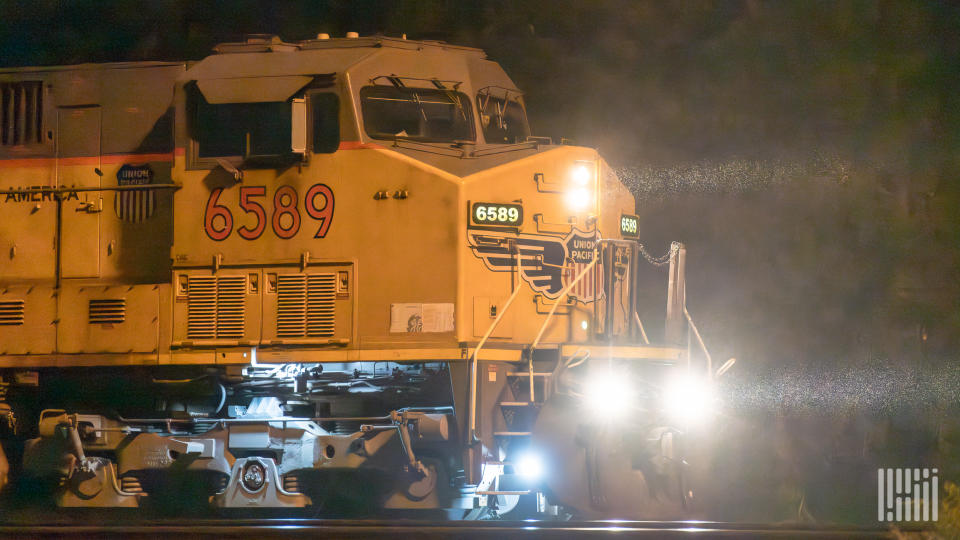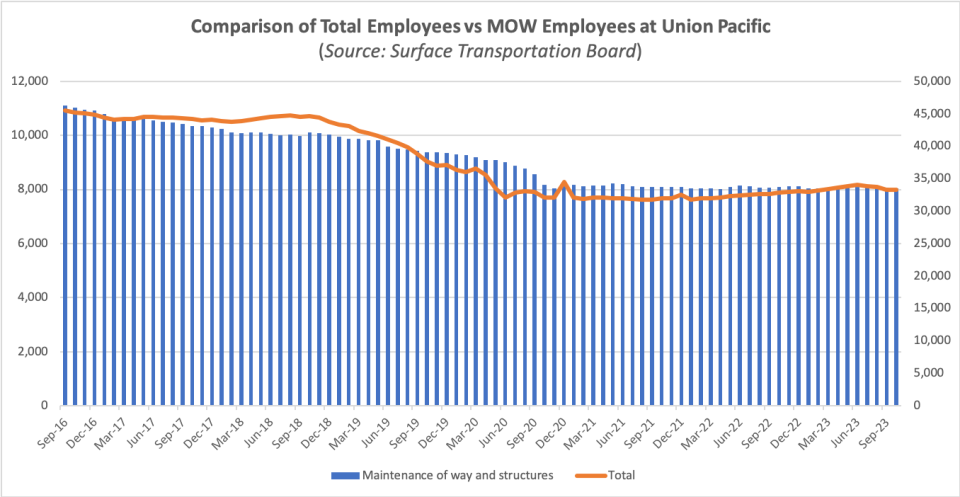Maintenance-of-way rail union and Union Pacific tussle over furloughs

Debate about furloughs at Union Pacific and how many employees could be affected continue to play out in the public arena following a recent industry conference where Surface Transportation Board Chairman Marty Oberman called out Union Pacific leadership.
The Brotherhood of Maintenance of Way – Employes Division (BMWED) sent two letters to the STB: one on Oct. 27 before the RailTrends conference in November hosted by Progressive Railroading and independent Wall Street analyst Tony Hatch and one letter after the conference dated Nov. 22.
At that conference, STB Chairman Marty Oberman sharply criticized UP’s decision to use furloughs, while UP President Beth Whited defended her company, saying that the railway’s normal maintenance program is on track and assuring the audience that UP would continue to meet rail service needs.
In BMWED’s two letters to STB, the union said UP (NYSE: UNP) was eyeing furloughing anywhere between 1,180 and 1,350 employees. Widespread disruptions on UP’s network during the first three quarters of this year, such as Tropical Storm Hilary in Southern California, have prompted UP to cut back on spending for budgeting reasons, including deferring some capital projects until 2024, according to BMWED, which is affiliated with the International Brotherhood of Teamsters.
Industry historically furloughed on a roughly seasonal basis until the railroads came under fire from federal regulators because of possible links between diminishing head count levels and deteriorating rail service. They are different from layoffs because furloughs imply that a worker may return to his or her job after a period of time, whereas layoffs imply that a person was let go from a company.
The Nov. 22 letter to the board from BMWED President Tony Cardwell and three union general chairmen also said UP hasn’t implemented large furloughs since 2015.
“While Union Pacific has assured the [Surface Transportation] Board that it is attempting to increase its workforce to improve resiliency (and foreswore future reliance on furloughs at the embargoes hearing, at the first whiff of a decline in profits (from record levels), Union Pacific has resorted to furloughs that are unprecedented in recent memory,” the letter said. “Union Pacific’s ability to recruit and retain skilled and highly qualified workers will be hindered by its cavalier treatment of its current workforce. The furloughs will agitate and destabilize the workforce, delay planned maintenance, impose unrealistic work expectations on Maintenance of Way employees, and undo the recruitment efforts of 2023.”
Cardwell’s Nov. 22 letter referred to and questioned Whited’s remarks at the conference, saying that maintenance-of-way (MOW) employees were discouraged from using vacation time during the holidays. The time off in December is not a reward but a furlough, he said.
“When Union Pacific imposes layoffs, it is not ‘allowing’ employees to take off work,” Cardwell said.
UP told FreightWaves on Monday that it could not pin down how many employees could be affected because a variety of circumstances play into furloughing decisions, including which positions are seasonal, when people go on vacation and whether people decide to seek employment elsewhere on the railroad instead of returning to their own jobs. The railroad also said that furloughs are a temporary work stoppage that occurs when work is not available but that UP intends to bring furloughed workers back to ensure it can continue to meet service and safety standards.
The Western U.S. Class I railroad pointed FreightWaves to a statement that it provided during the conference on the furloughs, which was that “accusations that Union Pacific does not invest in its infrastructure and maintenance are untrue. This year alone, the railroad will spend $3.7 billion on capital investment, of which a significant portion is allotted for maintenance.
“As part of the capital planning process, we are temporarily reducing some seasonal track maintenance positions. These seasonal shutdowns allow us to realign the work based on the upcoming year’s capital plan. Not all impacted jobs will result in employees being furloughed. Furloughs depend on a number of factors, including remaining paid time off, the number of open jobs and employee preference.”
Meanwhile, BMWED spokesperson Clark Bellew told FreightWaves on Monday that UP has indicated that it could furlough about 1,350 MOW employees. That number is concerning particularly because it could include not only newly hired employees but also long-tenured employees who have expertise and experience, Bellew said. BMWED, which is scheduled to meet with UP this week, is also uncertain how many furloughed employees will actually return to UP.
“It’ll be well worth watching if they bring back all 1,350 (we don’t expect they will because this is part of the [precision scheduled railroading] strategy). They might offer to bring some back but people can’t be out of work for months in limbo when they have bills to pay, so they will look for other work and write UP off,” Bellew said in an email. “They’ll claim they tried to bring back everyone but they know full well they will lose some employees and that is what they want. That saves them money.”
BMWED brings furlough debate before STB
BMWED had reached out to STB in part because it argues that UP’s proposed plan to cut back on spending — which BMWED views as a means to lower UP’s operating ratio — could also adversely affect service levels, which is an issue that the board has been monitoring.
OR is a metric that investors sometimes use to gauge the financial health of a company, with a lower OR implying improved financial health. The unions, including BMWED, have accused the Class I railroads of seeking to achieve lower OR as the impetus for the railroads’ implementation of precision scheduled railroading (PSR), a method adopted by the Class I railroads to streamline operations and lower costs.
BMWED argued that the furloughs also reflect a trend of diminishing headcount at UP within the last 10 years. While the Class I railroads have furloughed in the past, “historical patterns clearly demonstrate that significant workforce reductions through systematic furloughs tend to have enduring circumstances,” said BMWED’s Oct. 27 letter to STB.

UP “told the STB this year that they would increase workforce and they are brazenly and recklessly doing the opposite. They have not completed their scheduled planned track maintenance projects they set at the beginning of this year. They have work to do to get the track up to snuff, but that requires more investment than PSR is willing to devote,” BMWED’s Bellew said Monday.
“These types of furloughs haven’t occurred in the industry in several decades. They were once fairly common on a seasonal basis, but these carriers are so consolidated now that they can simply reassign production to the southern regions of their territories to avoid winter weather disruptions. U.P. is a 32,000 mile territory in 23 states. There is work to be done. Important work to ensure that they keep trains upright and communities safe,” Bellew continued.
While STB hasn’t formally responded to the letters aside from Oberman’s remarks at RailTrends, the board is monitoring the situation.
Unions also critical of Class I railroad head count levels
The specter of furloughs comes as labor attorney Richard S. Edelman submitted a separate and unrelated filing last week to STB about the Class I railroads’ consistently lower head count levels since the four main U.S. Class I railroads each individually adopted measures related to PSR, if not PSR itself, starting in 2017.
While head count levels have risen at the four main U.S. Class I railroads last year and this year, they are still hovering around levels seen at the onset of the COVID-19 pandemic in May 2020, according to monthly employment data that the railroads submit to STB.
However, these reductions in head count levels have “far exceeded the reductions in carloadings,” which means that “the reductions in numbers of employees has significantly increased the responsibilities (and attendant extra work time) for the employees who remain,” Edelman said.
The “Big 4” Class I railroads — UP, BNSF, CSX and Norfolk Southern — “have asserted that they have made strides in improving service and have increased employment; and they have rejected criticisms of their safety record, claiming that the number of derailments has been reduced in comparison to the number of derailments in the early 2000s. … [But] with respect to employment and service, the Big 4 are like a high jumper who sets the bar a foot off the ground, steps over it and awards himself/herself a medal,” Edelman said in his filing last Tuesday.
“The increases in employment have been minuscule in comparison to prior reductions in employment; and the improvements in service have taken service on some carriers from bad to substandard and others from abysmal to bad,” he said.
Edelman also argued that the industry’s interpretation of Federal Railroad Administration’s data showing a decrease in train derailments since 2000 is flawed because that data doesn’t reflect the reduction in train starts. Rather, Edelman argued that STB and others should look at FRA data on accidents/incidents per million train miles, which accounts for fewer but longer trains and shows that incidents have increased over the last decade.
“The Unions respectfully urge the Board to continue to press the railroads on the adequacy of the service they provide, and the adequacy of their workforces to provide levels of service that satisfy their common carrier obligations. The Unions again urge the Board to do all it can to enforce service standards and the common carrier obligation, and to advise Congress if the Board feels that it currently lacks sufficient authority to remedy service problems and enforce the common carrier,” Edelman said.
Edelman’s filing was submitted to Ex Parte 770, the proceeding on urgent issues in freight rail service.
In addition to representing BMWED before the board, Edelman also represents the Brotherhood of Railroad Signalmen; the International Association of Sheet Metal, Air, Rail and Transportation Workers – Mechanical Division; the International Association of Boilermakers; the International Association of Machinists and Aerospace Workers, District #19; the National Conference of Firemen and Oilers – 32BJ/SEIU; the Brotherhood of Locomotive Engineers and Trainmen affiliated with IBT; and the Transport Workers Union of America.
When asked about Edelman’s filing, the Association of American Railroads directed FreightWaves to its filing from July 7 to EP 770.
In that filing, the trade association representing freight railroads said that “the past decade has been the safest in railroad history,” with the hazardous materials accident rate down 76% from 2000 and the accident rate for Class I trains traveling on railroad mainlines down 48% between 2000 and 2022.
AAR also pointed to climbing employment totals, saying in its July filing that May was the 16th straight month in which the number of train and engine employees grew.
“While more hiring needs to and will be done, railroads are confident they will continue successfully recruiting the next generation of railroad workers to meet the nation’s rail freight demand,” AAR said.
Subscribe to FreightWaves’ e-newsletters and get the latest insights on freight right in your inbox.
Click here for more FreightWaves articles by Joanna Marsh.
Related links:
The post Maintenance-of-way rail union and Union Pacific tussle over furloughs appeared first on FreightWaves.
